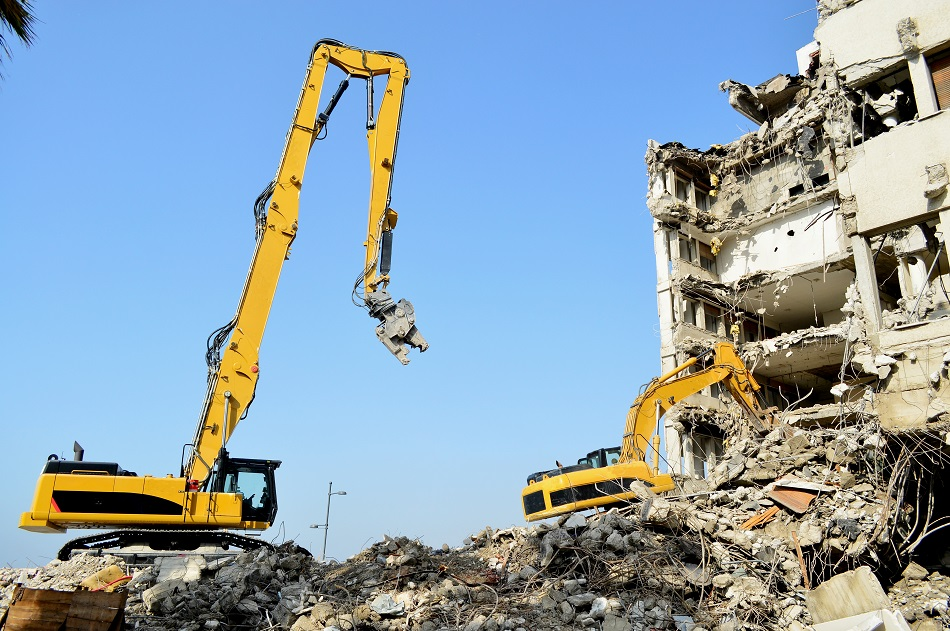
Image Credit: taylanozgurefe/Shutterstock.com
As of 2017, approximately 15% of all steel used globally can be found in tools and machinery. Within the construction industry, steel can be found in a wide variety of equipment and tools ranging from cranes, drills, and bulldozers to scaffolding material and portable shelters.
Common Demolition Equipment
Within the demolition sector of the construction industry, several tools are considered to be essential to any demolition project, including a long reach excavator, material handler, scrap shears, hydraulic hammer, wrecking ball, and pulverizer.
Each of these demolition tools plays a specific role in the demolition and/or renovation process. The long reach excavator, for example, is typically used during demolition projects involving tall structures, whereas the scrap shears are highly powerful scissors that are used to cut up large pieces of metal, like steel beams.
Steel Demolition Tools and Equipment
The superb strength of steel allows it to be widely incorporated into several different construction tools and machinery commonly found on demolition sites. Whether the steel is being incorporated into earthmoving equipment or as a thermal treatment for certain heavy components, its integration into this aspect of the construction industry has proved to be vital.
Demolition Tools
Steel can be found in a wide variety of simple tools that are commonly used for demolition and renovation projects. Demolition hammers, which are typically used for concrete work, are often comprised of steel because of their high durability. Additionally, rotary hammers, which are considered to be a less powerful demolition tool as compared to demolition hammers, are also steel-based tools that can drill holes, drive fasteners into a wide variety of material, and chip away at masonry and concrete.
Steels for Earthmoving
Earthmoving is a highly specialized construction task that benefits the use of robust equipment during various projects, including demolition. Due to the strength and toughness requirements of most earthmoving tasks, it is not uncommon for steel to be used during the manufacturing of this machinery.
ArcelorMittal Europe, which is a multinational steel manufacturing corporation located in Luxembourg City, provides its customers with a full range of steel earthmoving products for such demolition purposes. The ArcelorMittal Amstrong® range of high strength low alloy steels, for example, have demonstrated their unique ability to reduce both the structural thickness and weight of machinery while simultaneously maintaining an excellent load-bearing capacity and fatigue resistance. Some of the most common applications of the Amstrong® range can be found in mobile cranes, crawler cranes, various work tools used for demolition projects, and much more.
Steel-Treated Machinery
The extreme stress that most construction equipment is exposed to daily can cause these pieces of machinery to be particularly vulnerable to fatigue, wear, and abrasion, which can significantly shorten the lifespan of these systems. To improve reliability whilst also extending the lifespan of construction equipment, many companies will turn to steel treating processes.
Steel heat and thermal treatments can range from carburizing, carbonitriding and ferritic nitrocarburizing to normalizing, annealing, and stress relieving processes, each of which can improve the strength and durability of construction equipment for operational use. Companies like Specialty Steel Treating, Inc. (SST), which is an American company that provides a wide range of steel heat treatment services, have specialized engineering segments that are dedicated to improving the performance of construction and earth-moving equipment. Some of the most common steel heat treatment services that SST utilizes for construction and demolition equipment include oil quenching, tempering steel, quenching steel, gas carburizing, and surface hardening.
Sources and Further Reading
Disclaimer: The views expressed here are those of the author expressed in their private capacity and do not necessarily represent the views of AZoM.com Limited T/A AZoNetwork the owner and operator of this website. This disclaimer forms part of the Terms and conditions of use of this website.